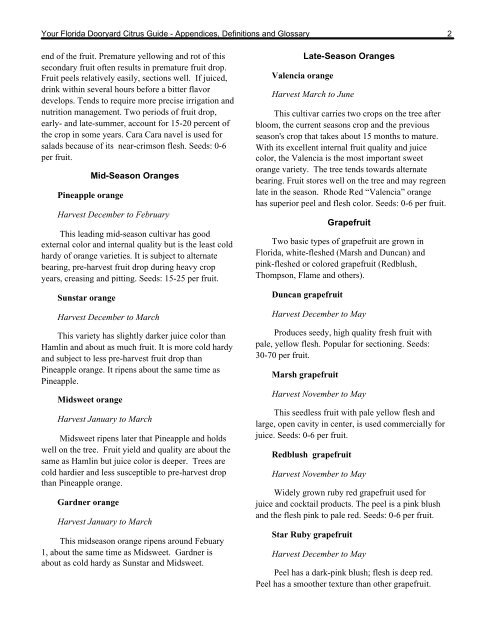Dooryard Citrus Guide - Appendices, Definitions and Glossary
Dooryard Citrus Guide - Appendices, Definitions and Glossary
Dooryard Citrus Guide - Appendices, Definitions and Glossary
Create successful ePaper yourself
Turn your PDF publications into a flip-book with our unique Google optimized e-Paper software.
Your Florida <strong>Dooryard</strong> <strong>Citrus</strong> <strong>Guide</strong> - <strong>Appendices</strong>, <strong>Definitions</strong> <strong>and</strong> <strong>Glossary</strong> 2<br />
end of the fruit. Premature yellowing <strong>and</strong> rot of this<br />
secondary fruit often results in premature fruit drop.<br />
Fruit peels relatively easily, sections well. If juiced,<br />
drink within several hours before a bitter flavor<br />
develops. Tends to require more precise irrigation <strong>and</strong><br />
nutrition management. Two periods of fruit drop,<br />
early- <strong>and</strong> late-summer, account for 15-20 percent of<br />
the crop in some years. Cara Cara navel is used for<br />
salads because of its near-crimson flesh. Seeds: 0-6<br />
per fruit.<br />
Pineapple orange<br />
Mid-Season Oranges<br />
Harvest December to February<br />
This leading mid-season cultivar has good<br />
external color <strong>and</strong> internal quality but is the least cold<br />
hardy of orange varieties. It is subject to alternate<br />
bearing, pre-harvest fruit drop during heavy crop<br />
years, creasing <strong>and</strong> pitting. Seeds: 15-25 per fruit.<br />
Sunstar orange<br />
Harvest December to March<br />
This variety has slightly darker juice color than<br />
Hamlin <strong>and</strong> about as much fruit. It is more cold hardy<br />
<strong>and</strong> subject to less pre-harvest fruit drop than<br />
Pineapple orange. It ripens about the same time as<br />
Pineapple.<br />
Midsweet orange<br />
Harvest January to March<br />
Midsweet ripens later that Pineapple <strong>and</strong> holds<br />
well on the tree. Fruit yield <strong>and</strong> quality are about the<br />
same as Hamlin but juice color is deeper. Trees are<br />
cold hardier <strong>and</strong> less susceptible to pre-harvest drop<br />
than Pineapple orange.<br />
Gardner orange<br />
Harvest January to March<br />
This midseason orange ripens around Febuary<br />
1, about the same time as Midsweet. Gardner is<br />
about as cold hardy as Sunstar <strong>and</strong> Midsweet.<br />
Valencia orange<br />
Late-Season Oranges<br />
Harvest March to June<br />
This cultivar carries two crops on the tree after<br />
bloom, the current seasons crop <strong>and</strong> the previous<br />
season's crop that takes about 15 months to mature.<br />
With its excellent internal fruit quality <strong>and</strong> juice<br />
color, the Valencia is the most important sweet<br />
orange variety. The tree tends towards alternate<br />
bearing. Fruit stores well on the tree <strong>and</strong> may regreen<br />
late in the season. Rhode Red “Valencia” orange<br />
has superior peel <strong>and</strong> flesh color. Seeds: 0-6 per fruit.<br />
Grapefruit<br />
Two basic types of grapefruit are grown in<br />
Florida, white-fleshed (Marsh <strong>and</strong> Duncan) <strong>and</strong><br />
pink-fleshed or colored grapefruit (Redblush,<br />
Thompson, Flame <strong>and</strong> others).<br />
Duncan grapefruit<br />
Harvest December to May<br />
Produces seedy, high quality fresh fruit with<br />
pale, yellow flesh. Popular for sectioning. Seeds:<br />
30-70 per fruit.<br />
Marsh grapefruit<br />
Harvest November to May<br />
This seedless fruit with pale yellow flesh <strong>and</strong><br />
large, open cavity in center, is used commercially for<br />
juice. Seeds: 0-6 per fruit.<br />
Redblush grapefruit<br />
Harvest November to May<br />
Widely grown ruby red grapefruit used for<br />
juice <strong>and</strong> cocktail products. The peel is a pink blush<br />
<strong>and</strong> the flesh pink to pale red. Seeds: 0-6 per fruit.<br />
Star Ruby grapefruit<br />
Harvest December to May<br />
Peel has a dark-pink blush; flesh is deep red.<br />
Peel has a smoother texture than other grapefruit.
















